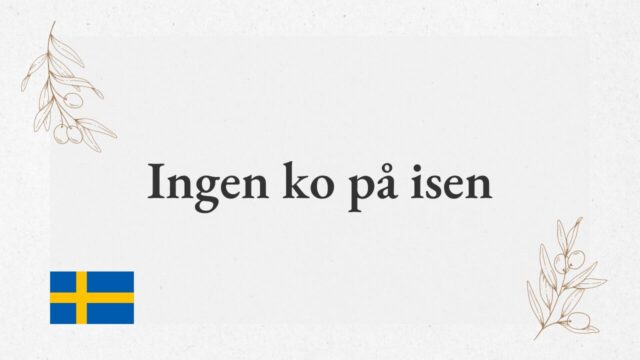“Det är ingen ko på isen så länge rumpan är I land” – As long as the backside is on land, there’s no cow on the ice

Meaning
“Det är ingen ko på isen så länge rumpan är i land” means “As long as the backside is on land, there’s no cow on the ice.” This expression conveys the idea that “it’s not dangerous yet” or “for now, there’s no need to worry.” It is used particularly in situations where there is a potential risk or a looming problem, but the situation is not yet critical or urgent.
For instance, if there is a possibility of a significant issue arising, but there is no immediate need for action, this phrase would be appropriate. It suggests that while one should keep an eye on the situation, there is no need for drastic measures at the current moment.
Origin
In old Sweden, having a cow wander onto a frozen lake was a dangerous scenario. If the ice cracked and the cow fell into the water, it could result in a life-threatening situation. Therefore, a cow on the ice signaled a serious problem. However, this expression adds the detail “as long as the backside is on land,” implying that the cow hasn’t fully ventured onto the ice yet, so there is no immediate cause for concern.
This metaphor, derived from the practical experiences of rural life, continues to be used today to provide reassurance that “the situation hasn’t worsened yet.” It reflects a sense of calm based on firsthand knowledge of the risks associated with ice and livestock.
Difference from “Ingen ko på isen”
In Swedish, there is also the phrase “Ingen ko på isen,” which means “There’s no cow on the ice” and is used to indicate that “there’s nothing to worry about” or “there’s no problem.”
On the other hand, “Det är ingen ko på isen så länge rumpan är i land” includes the nuance of “The situation isn’t completely safe, but there’s no immediate danger.” In other words, “Ingen ko på isen” is a simpler expression that means “nothing to worry about,” while “Det är ingen ko på isen så länge rumpan är i land” implies, “It’s not dangerous yet, but we shouldn’t be complacent.” This distinction is used when the situation isn’t currently dangerous but still requires monitoring. “Ingen ko på isen” is used when there’s absolutely no cause for concern, whereas “Det är ingen ko på isen så länge rumpan är i land” is more cautious and suggests the need for continued vigilance.

Conclusion
“Det är ingen ko på isen så länge rumpan är i land” is a Swedish proverb meaning “It’s not entirely safe, but the situation hasn’t worsened yet.” The idea comes from the rural wisdom that having a cow on the ice is dangerous, but if the cow’s backside is still on solid ground, there’s no immediate risk.
This expression is used to describe a situation where one should remain alert but does not need to act urgently, reflecting Sweden’s natural environment and historical experiences. It emphasizes the importance of paying attention while still acknowledging that, for now, there is no pressing danger.




